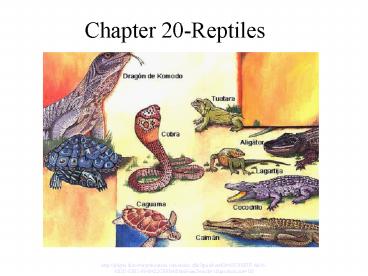Chapter 20-Reptiles - PowerPoint PPT Presentation
1 / 25
Title:
Chapter 20-Reptiles
Description:
... vipers and copperheads http://vimeo.com/3263747 Order Squamata/Suborder Serpentes- Venomous Snakes Coral snake King cobra Krait Sea snake Puff adder Eyelash ... – PowerPoint PPT presentation
Number of Views:213
Avg rating:3.0/5.0
Title: Chapter 20-Reptiles
1
Chapter 20-Reptiles
http//player.discoveryeducation.com/index.cfm?gui
dAssetId63C88B7F-A656-43DD-83E5-F640422CEFB4blnF
romSearch1productcodeUS
2
Class Reptilia
- Snakes, lizards, skinks, turtles, and
crocodilians - Strong, bony skeleton and toes w/claws
- Ectothermic metabolism
- Dry, scaly skin
- Amniotic eggs
- Respiration through well-developed lungs
- Ventricle of heart partly divided by a septum
- Internal fertilization
3
Ectothermic Metabolism
- Metabolism too slow to generate own body heat
- Intolerance to cold-become sluggish and unable to
function - Absorb heat from environment
- Basking in sun to heat up
- Shade to cool down
- Maintain relatively constant by alternating
4
Sun Basking
5
Water Retention
Overlapping Scales
- Do not lose water through skin or require water
to reproduce like amphibians - Skin -light and flexible scales
- Overlapping minimizes water loss
- Enables reptiles to live in dry environments
6
Watertight Eggs
Amniotic Eggs
- Fertilized eggs need moisture to develop
- Internal fertilization allows for moisture to
surround eggs - Amniotic egg- Tough-shelled egg containing a
water and food supply - Most reptiles
- All birds
- Some mammals
7
Respiration
- Lungs w/many folds increase gas exchanging
surface - Strong muscles attach to rib sage aid expansion
and contraction of lungs
- Incomplete septum separates ventricle of heart
- Crocodilians have completely divided ventricle
- Complete septum separates atrium of heart
- More separation of oxygen-rich and oxygen-poor
blood - Oxygen delivered to body cells more efficiently
8
Reptilian Heart Structure
9
Reproduction
- Internal fertilization- Male introduces semen
directly into females body - Protects gametes from drying out
- Oviparous (most)- Young hatch from eggs
- Most cases parents do not protect
- Ovoviviparous (some)- Female retains eggs in body
until just before hatching sometimes hatching
occurs in mother - Eggs less vulnerable to predation
- Nourishment of eggs from yolk
10
Order Squamata
- Includes lizards and snakes
- Lower jaw loosely connected to skull
- Mostly carnivores some herbivores
- Mouth opens wide to accommodate prey
- Extremely successful predators
http//video.search.yahoo.com/video/play?pkomodo
dragonseiUTF-8vmrfryfp-t-501tnr21vid0001
64848944
11
Order Squamata/Suborder Sauria- Lizards
- Mostly small (lt30 cm)
- Largest Kimodo dragons (lt3 m)
- Tail may break off to avoid predation
(regenerates w/no vertebrae) - Molt skin periodically
- Include
- Iguanas
- Chameleons
- Geckos
- Anoles
- Horned lizards
- Monitors
- Skinks
http//video.search.yahoo.com/video/play?pjesusl
izardn21eiutf-8js1vmrfryfp-t-501tnr20
vid000163111524
12
Order Squamata/Suborder Sauria- Lizards
Green Iguana
Veiled chameleon
Leopard Gecko
Anole
Texas horned lizard
Nile monitor
13
Order Squamata/Suborder Serpentes- Snakes
Gaboon viper
- Legless w/no eyelids nor external ears
- No pectoral girdle
- Five-point movement in jaw
- Elastic ligament allows lower jaw to spread
- No chewing or cutting teeth
- Ovoviviparous
- 2/3 in family Colubridae and non-venomous
Green tree python
14
Order Squamata/Suborder Serpentes- Snakes
- Several hundred vertebrae
- Jacobsons Organs- Depressions in roof of mouth
detect smell - Feeding All snakes subdue prey and swallow whole
- Constrictors squeeze prey until suffocation
- Anacondas, boas, pythons, and king snakes
Ball python
http//video.search.yahoo.com/video/play?pconstri
ctorn21eiutf-8js1vmrfryfp-t-501tnr20v
id000164319803
15
Order Squamata/Suborder Serpentes/Family Boidae-
Constrictor Snakes
Anaconda
Emerald tree boa
Banded king snake
Scarlet king snake
16
Order Squamata/Suborder Serpentes- Snakes
- Venomous snakes
- Modified salivary glands produce venom to inject
into prey with grooved or hollow teeth - Families
- Elapidae- Cobras, kraits, mambas, taipans, and
coral snakes - Hydrophiidae- Sea snakes
- Viperidae- Rattlesnakes, moccasins, adders,
vipers and copperheads
http//vimeo.com/3263747
17
Order Squamata/Suborder Serpentes- Venomous
Snakes
Coral snake
King cobra
Krait
Sea snake
Puff adder
Eyelash viper
18
Order Squamata/Suborder Serpentes- Venomous Snakes
Water mocassin (a.k.a. Cottonmouth)
Copperhead
19
Order Squamata/Suborder Serpentes- Rattlesnakes
- Rattle- 5 to 7 rings of keratin and protein
- New ring each molt
- Pit organ- Openings between eye and nostril
detect infrared - Venom- Hemotoxin affects red blood cells causing
hemorrhaging
Timber rattlesnake
Diamondback rattlesnake
20
Order Squamata/Suborder Amphisbaenia- Worm Lizards
- 135 species
- Amphis double baen to walk
- Move easily backwards and forwards
- Burrowers
- Unique single median tooth on upper jaw
- Annuli ring-like folds in skin
- Oviparous Feed on worms and small insects
21
Order Chelonia (Testudines)- Turtles and Tortoises
Gopher tortoise
- 250 species
- Body encased in shell
- Bony plates covered w/leathery skin
- Vertebrae fused to dorsal
- Provides support for muscles
- Some for protection
- Carapace- dorsal part of the shell
- Plastron- Ventral
- No teethpowerful beak
- Many herbivores some carnivores
Giant tortoise
22
Order Chelonia (Testudines)- Turtles and Tortoises
Alligator snapping turtle
- Turtles- Stream-lined, disk-shaped shell for
water movement - Tortoises- Dome- shaped shell
Box turtle
Sea turtle
23
Order Crocodilia- Alligators, Crocodiles,
Caimans, and Gavials
Caiman
- Large aggressive carnivores
- Capture prey by stealth, drowns, and eats
- Eyes and nostrils on top of head to allow for
seeing and breathing while under water - Strong neck w/large mouth (100s of sharp teeth)
- Throat valve prevents water entering into lungs
- Uniquely care for young after hatching
Gavial
24
Order Crocodilia- Alligators, Crocodiles,
Caimans, and Gavials
American alligator
Nile crocodile
http//player.discoveryeducation.com/index.cfm?gui
dAssetId0F4A5549-9B4D-422D-A596-B407CE406BE1blnF
romSearch1
25
Order Rhynchocephalia- Tuataras
- Native to New Zealand
- Lizard-like
- Uniquely active at low temp./night
- Unchanged for 150 million yrs.
- 2 species
- Genus Sphenodon































